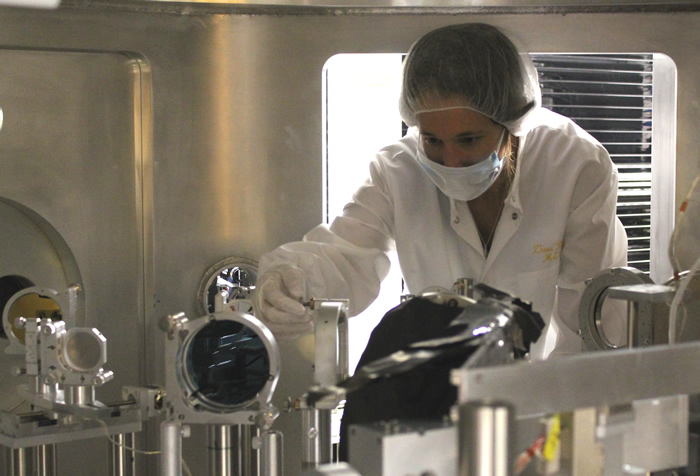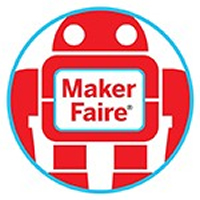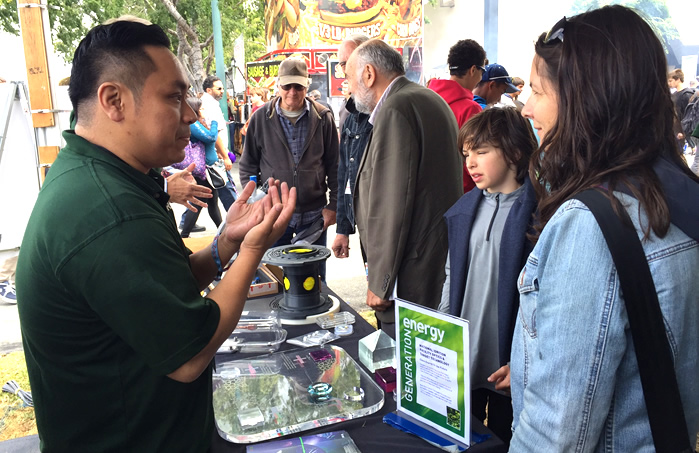NIF & PS People - 2016
May
NIF Technology Highlighted at Bay Area Maker Faire
Félicie Albert Receives DOE Early Career Research Award
NIF & Photon Science physicist Félicie Albert has been selected by the Department of Energy’s Office of Fusion Energy Sciences to receive funding as part of DOE’s Early Career Research Program. The effort, now in its seventh year, is designed to bolster the nation’s scientific workforce by providing support to exceptional researchers during the crucial early career years, when many scientists do their most formative work.
 Félicie Albert
Félicie Albert Albert is among 49 scientists from across the nation, including 22 from DOE’s national laboratories and 27 from U.S. universities, who will receive significant funding for their research. Albert will use her five-year, $2.5 million grant to work on the physics and applications of laser-driven x rays for high energy density science at large-scale facilities, including NIF’s Advanced Radiographic Capability (ARC) and the Linac Coherent Light Source (LCLS) at the SLAC National Accelerator Laboratory in nearby Menlo Park, CA.
“We invest in promising young researchers early in their careers to support lifelong discovery science to fuel the nation’s innovation system,” said Cherry Murray, director of DOE’s Office of Science. “We are proud of the accomplishments these young scientists already have made, and look forward to following their achievements in years to come.”
Under the program, university-based researchers will receive at least $150,000 per year to cover summer salary and research expenses. For researchers based at DOE national laboratories, where DOE typically covers full salary and expenses of laboratory employees, grants will be at least $500,000 per year to cover year-round salary plus research expenses. The research grants are planned for five years.
“I am incredibly grateful and honored to have won this award,” Albert said. “I cannot think of a better time and place to pursue this project; the next five years are going to be very exciting. I am looking forward to working with some of the world’s most fascinating lasers, including ARC and the LCLS, which are right around the corner from my office.
 Félicie Albert aligns the laser beam path for an experiment on the Matter Under Extreme Conditions end station at SLAC’s Laser Coherent Light Source.
Félicie Albert aligns the laser beam path for an experiment on the Matter Under Extreme Conditions end station at SLAC’s Laser Coherent Light Source. “Due to their remarkable spectral, spatial, and temporal properties, x-ray sources from laser-plasma accelerators hold great promise as probes for high energy density science experiments,” she said, “but at large-scale laser facilities, they haven’t really been used to probe plasmas under extreme conditions of temperature and pressure.
“The experiments that led to this award always require large collaborations, and I could not have won it without the support and dedication of many collaborators, colleagues and mentors. I am very fortunate to always learn from them and to work in such a stimulating environment.”
Albert, an expert in ultrafast x-ray sources and laser-plasma interactions, joined LLNL as a postdoctoral researcher in 2008 and became a permanent member of the scientific staff in 2010. She earned her PhD in physics from the Ecole Polytechnique in France in 2007 and her M.S. in optics from the University of Central Florida in 2004.
Her areas of interest include the generation of novel sources of electrons, x rays, and gamma rays through laser-plasma interaction, Compton scattering, and laser-wakefield acceleration. She has worked on the Laboratory’s laser-Compton light source technology and has been leading Laboratory Directed Research and Development projects to study and develop the betatron x-ray source. She has conducted many experiments using high-intensity lasers, including NIF, LLNL’s Jupiter Laser Facility, and the LCLS.
To be eligible for the DOE award, a researcher must be an untenured, tenure-track assistant or associate professor at a U.S. academic institution or a full-time employee at a DOE national laboratory who received a PhD within the past 10 years. Awardees were selected from a large pool of university- and national laboratory-based applicants. Selection was based on peer review by outside scientific experts.
NIF Technology Highlighted at Bay Area Maker Faire
An exhibit of NIF targets and optics was among the displays mounted by LLNL and the U.S. Department of Energy (DOE) at the 11th annual Bay Area Maker Faire, dubbed the “Greatest Show (and Tell) on Earth.” The event was held from May 20 to 22 at the San Mateo Event Center.
dubbed the “Greatest Show (and Tell) on Earth.” The event was held from May 20 to 22 at the San Mateo Event Center.
The NIF booth was part of the first-ever Maker Faire Make | ENERGY Pavilion, where attendees were able to interact with scientists and DOE makers, share their ideas about transformative science projects and technology solutions, and learn how they can get involved in the future of energy.
Attendees also had the opportunity to “meet the makers” behind DOE technologies and ask questions about the world-class capabilities of DOE’s national labs. The DOE labs also were featured during two panel discussions on May 21.
Created by Maker Media, Maker Faires are family-friendly showcases of invention, creativity and resourcefulness where people of all ages and backgrounds can gather to show what they are making and share what they are learning.
 Henry Hui describes NIF targets and optics to visitors at the 11th annual Bay Area Maker Faire. Credit: Breanna Bishop
Henry Hui describes NIF targets and optics to visitors at the 11th annual Bay Area Maker Faire. Credit: Breanna Bishop In 2015, Maker Faires attracted more than 1.2 million attendees in more than 30 countries around the world. Last year’s Bay Area Maker Faire welcomed some 1,200 makers and 145,000 visitors.
This year DOE participated as a Goldsmith Sponsor, showing its commitment to the innovative mindset of makers and making its national laboratories more transparent and accessible to makers everywhere.




